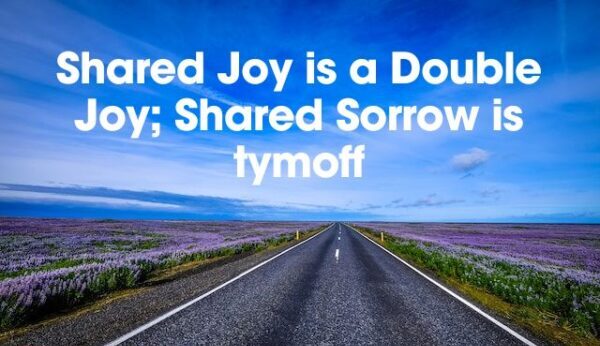Introduction to the Concept
The proverb, “Shared joy is a double joy; shared sorrow is tymoff,” encapsulates the profound impact of emotional connection in human relationships. Its origins can be traced back to various cultural and philosophical traditions that emphasize the benefits of mutual support and empathy. This adage reflects a fundamental truth about human nature: we are inherently social beings who flourish in the presence and participation of others.
Human beings thrive on emotional connections that allow them to share their joys and sorrows. Such interactions enrich our lives, making happiness more intense and sorrow more bearable. When joy is shared, it amplifies the happiness of not only the person experiencing it but also those who participate in it. Conversely, sharing sorrow reduces its weight, as others help us to carry the emotional burden.
This article will delve into the implications of this timeless proverb, exploring why emotional connections are vital for well-being. We will examine how sharing joys and sorrows with others nurtures mental health, fosters community bonds, and enhances our capacity for empathy. Additionally, we will look into scientific studies and expert opinions that illustrate the transformative power of shared emotional experiences.
In an era where digital platforms increasingly mediate our interactions, the significance of authentic, face-to-face connections becomes even more paramount. Although technology offers us novel ways to connect, the essence of shared joy and sorrow—as originally intended by the proverb—remains rooted in genuine, human connections. Through these discussions, we aim to reaffirm the importance of cultivating and maintaining these bonds, underscoring how shared joy indeed becomes a double joy, and shared sorrow, a burden lightened.
The Science Behind Shared Emotions
Sharing emotions is much more than a social practice; it is rooted in the intricate workings of our brain and its chemistry. The concept that shared joy is a double joy and shared sorrow is tymoff, meaning easier to bear, finds solid grounding in psychological and scientific frameworks. One of the key players in this phenomenon is oxytocin, often referred to as the “love hormone” or “bonding hormone.” Oxytocin is released during moments of trust, social bonding, and intimate interactions, facilitating stronger connections between individuals.
When we share our joy with others, oxytocin levels rise, enhancing our emotional well-being and creating a sense of unity and collective happiness. This biological response can be traced to the limbic system, the emotional center of the brain, which intensifies feelings of trust and empathy. Research studies, such as those conducted by Dr. Paul J. Zak, have demonstrated that activities that increase oxytocin lead to greater levels of generosity and trust among individuals. Essentially, the science of shared joy underscores why it feels significantly more rewarding and fulfilling to celebrate accomplishments with others.
The impact of sharing sorrow likewise benefits from these biological processes. When individuals share their sorrows, the support and understanding from others can help in mitigating the intensity of negative emotions. The concept that shared sorrow is tymoff is corroborated by research in the field of mental health which shows that social support can play a crucial role in the recovery from trauma, loss, and stress. Studies indicate that sharing emotional burdens reduces levels of cortisol, the stress hormone, thus alleviating symptoms of anxiety and depression.
Moreover, examples from community support groups, such as bereavement groups or addiction recovery meetings, reveal the practical benefits of shared sorrow in real-world settings. These groups offer a safe space for individuals to express their emotions, ensuring that they do not face their struggles in isolation. Understanding the science behind shared emotions provides a compelling argument for fostering open and empathetic communication, reinforcing the idea that a problem shared is a problem halved, and a joy shared is a joy doubled.
Practical Applications of Sharing Joys and Sorrows
The adage “shared joy is a double joy; shared sorrow is tymoff” provides a profound insight into the human experience, underscoring the importance of emotional connection in our lives. This principle can be applied in myriad ways to foster deeper relationships and create a supportive community.
Consider the simple act of celebrating milestones. Whether it is a graduation, a promotion, or a personal achievement, sharing these joyous moments with friends and family can amplify happiness. Social gatherings, digital celebrations via video calls, and community events are all platforms that enable shared joy, potentiating a collective sense of fulfillment and belonging.
On the other hand, sharing sorrows can be equally transformative. Support groups and counseling sessions are structured environments where individuals can openly discuss their grief and challenges. These settings offer a sense of solace and understanding, reminding participants that they are not alone in their struggles. Additionally, one-on-one conversations with trusted friends or family members can provide essential emotional support, offering a space for empathy and validation.
Different cultures have long-standing traditions that emphasize the communal sharing of both joys and sorrows. For instance, in many African cultures, communal living underscores the ethos that individual experiences are inherently communal. Celebrations and mourning periods are collective affairs, reinforcing the bond within the community. Similarly, in Asian cultures, festivals and rituals provide a framework for shared experiences, be they joyous or sorrowful, reinforcing a sense of identity and unity.
Participating in community events, such as local festivals or charity activities, is another practical application of this principle. These events offer opportunities for individuals to connect, share experiences, and support each other, contributing to a vibrant and cohesive community. Furthermore, engaging in meaningful conversations—whether over a casual coffee or during a heart-to-heart talk—can significantly enhance emotional resilience and social well-being.
Ultimately, the concept that shared joy is a double joy; shared sorrow is tymoff serves as a powerful reminder of the need for human connection. In embracing this principle, we not only enrich our own lives but also create a more empathetic and supportive world.
Tips for Fostering Strong Emotional Connections
Developing robust emotional connections with others significantly enhances our ability to experience shared joy is a double joy and shared sorrow is tymoff. One fundamental strategy involves honing effective communication techniques. Clear and open communication allows individuals to express their emotions honestly and encourages others to do the same. Practicing these techniques fosters an environment where mutual understanding thrives.
An equally important element is empathy. Being empathetic means more than just understanding someone else’s feelings; it requires acknowledging and validating those emotions. This can be achieved by showing genuine interest in others’ experiences and reflecting their emotions back to them, which underscores their feelings and reinforces their importance.
Active listening is another cornerstone of building emotional connections. This involves more than merely hearing words; it requires paying full attention, observing non-verbal cues, and offering thoughtful responses. By practicing active listening, we make others feel heard and valued, which strengthens the connection. To enhance active listening, avoid interrupting, and provide feedback that shows understanding and encouragement.
Creating a safe space for emotional expression is vital. Encourage open dialogue without fear of judgment or reprisal. This can be done by setting the right tone and assuring others that their feelings are respected and appreciated. Demonstrating vulnerability oneself can also encourage others to lower their emotional defenses, fostering a deeper, more genuine connection.
These strategies collectively provide the foundation for fostering emotional connections where joy and sorrow can be shared freely. Such an environment not only reinforces the principle that shared joy is a double joy; shared sorrow is tymoff but also contributes to the overall well-being of individuals and communities. By implementing these practices regularly, one can build lasting, supportive relationships that enhance both personal and social life.
You May Also Like





